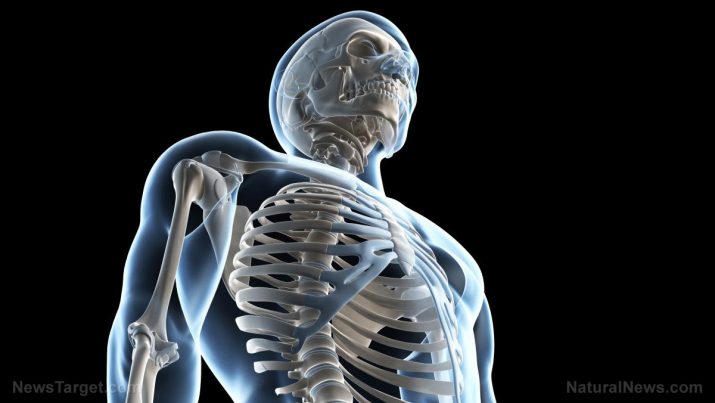
Marfan syndrome – causes, side effects and treatments at NaturalPedia.com
Tuesday, June 05, 2018 by Zoey Sky
http://www.naturalpedia.com/marfan-syndrome-causes-side-effects-and-treatments-at-naturalpedia-com.html

Marfan syndrome refers to a disorder that affects the connective tissue.
Connective tissues are proteins that support bones, blood vessels, other organs, and skin. Fibrillin is one such protein, and a problem with the fibrillin gene causes Marfan syndrome.
Patients can develop mild to severe cases of the disorder and its symptoms may vary. Individuals with Marfan syndrome are usually loose-jointed and very tall and thin.
It may take several tests before a patient is diagnosed with Marfan syndrome. A healthcare professional can use a patient’s family history, medical history, and a physical exam to diagnose the disorder.

Known side effects of Marfan syndrome
Marfan syndrome usually affects different body parts and side effects may vary per individual. Patients with the disorder have a unique physical build.
The side effects of Marfan syndrome that involve the skeletal system may include:
- Flat feet
- A high palate and/or small bottom jaw that may cause speech disorders
- A long and narrow face
- Long limbs with thin and weak wrists
- Overcrowded teeth
- Pain in the bones, joints, and muscles
- A protruding or caved in breastbone/sternum
- A slim body that’s taller than the average height
- Stooped shoulders
- Stretch marks on the skin not caused by pregnancy or weight gain
- Very flexible joints
- Very long and slender fingers and toes, or both
Patients with Marfan syndrome usually have an arm span longer than their height.
Side effects of the disorder linked to the eyes can include:
- Astigmatism
- Cataracts
- Detached retinas
- Dislocation of the lens
- Early-onset glaucoma
- Nearsightedness
The aortic irregularities in a patient can cause side effects like:
- Angina, which is linked to pain in the chest that spreads to the arm, back, or shoulder
- Aortic aneurysm
- Dilated aorta
- Fatigue
- Heart murmur or palpitations
- Prolapse of the heart valves and the aorta
- Shortness of breath
Risk factors for Marfan syndrome may include:
- A family history of the disorder
- Sporadic mutations linked to advanced paternal age
Body systems harmed by Marfan syndrome
Marfan syndrome may cause complications like damage to the heart valves, aorta, or both.
Food items or nutrients that may prevent Marfan syndrome
The following foods or nutrients can help prevent Marfan syndrome and strengthen connective tissue:
- Copper — A trace mineral, copper is crucial to hemoglobin production, a component of red blood cells. Copper can boost the production of myelin, which surrounds nerve endings to reduce toxic damage. Copper can also strengthen connective tissue by increasing collage production for connective tissue repair. Sources include crab meat, nuts (e.g., almonds and hazelnuts), soybeans, and tomatoes.
- Vitamin C — Vitamin C can stimulate the immune system and boost interferon production, which also helps fight off infections. It can also help minimize inflammation of connective tissue. Sources include bell peppers, cantaloupe, citrus fruits, kiwi fruit, papaya, and spinach.
- Vitamin E — Vitamin E is stored in the fat tissues of the body. An antioxidant, vitamin E can help prevent connective tissue damage due to free radical molecules and oxidized low-density lipoproteins. Vitamin E can also boost the body’s collagen production that helps repair and strengthen connective tissue. Sources include almonds, asparagus, avocados, eggs, kale, and sunflower seeds.
- Zinc — Zinc can help stimulate immune system function. A trace mineral, zinc can also help prevent connective tissue deterioration due to bacterial and viral infection. Additionally, zinc is an antioxidant and it can also help encourage collagen production. Sources include lentils, mushrooms, pumpkin seeds, sardines, and tofu.
Treatments, management plans for Marfan syndrome
While Marfan syndrome has no cure, treatments can help delay or prevent complications linked to the condition. Depending on the body parts affected and to what degree, constant monitoring and treatment for Marfan syndrome can include:
- A course of antibiotics to prevent infection before surgery that may involves the genitals, teeth, or urinary system to minimize the risk of heart valve problems, like infection/endocarditis.
- Annual echocardiogram tests to monitor heart and aorta size and function.
- Annual eye examinations and treatment.
- Heart surgery, like surgical repair of valves and aorta.
- Lifestyle changes.
- Medication, like beta-blockers, to lower blood pressure and relieve any strain on the cardiovascular system.
- Regular check-ups to monitor the skeleton/corrective treatment (when necessary).
Where to learn more
- Clean your Body’s Drains: How to Detoxify your Lymphatic System
- Coconut oil: A true Magic Bullet
- Take the versatile approach to better bone health
- Top six diseases and disorders that barely existed in America 100 years ago, yet most MDs tell us they’re “genetic” … Why?
- Yoga can increase blood flow, aiding in repair and regeneration of tissue
Summary
Marfan syndrome refers to a disorder that affects the connective tissue.
The side effects of Marfan syndrome that involve the skeletal system may include flat feet, long limbs with thin and weak wrists, and overcrowded teeth.
Marfan syndrome may cause complications like damage to the heart valves, aorta, or both.
Copper, vitamin C, vitamin E, and zinc can help strengthen connective tissue in patients with the disorder.
While Marfan syndrome has no cure, treatments like medication or surgery can help delay or prevent complications associated with the condition.
Sources include:
Tagged Under: Tags: Marfan syndrome





